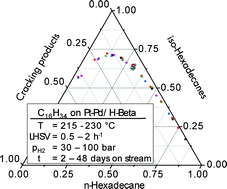Hydroisomerization of long-chain paraffins over nano-sized bimetallic Pt–Pd/H-beta catalysts†
Abstract
The hydroisomerization of long-chain n-paraffins was studied in the temperature range of 205–230 °C at pH2 = 50 bar using a pilot-scale trickle-bed continuous-flow reactor over bimetallic catalysts consisting of mixtures of platinum and palladium supported on commercially available nano-sized zeolite beta (nSi/nAl = 12.5 and 25, respectively) extruded with an alumina binder. For n-hexadecane conversion, high yields of isomers (25 and 45 wt.% of mono- and multibranched isomers, respectively) without extensive cracking (>10 wt.%) were obtained at a conversion of 80%. Long-term tests with n-hexadecane and blends of solid n-paraffins for 30–60 days on-stream clearly indicate that a minor loss in catalyst activity can easily be compensated for by increasing the reaction temperature from 220 °C to 225 °C. The zeolite with a “mild acidity” exhibits a low hydrocracking activity with isomerization yields of up to 70 wt.% and high stability over more than 60 days on-stream. Carbonaceous deposits formed during n-paraffin hydroisomerization were investigated by elemental analysis, TGA, ATR-FTIR and 13C MAS NMR spectroscopy, showing the formation of hydrogen-rich coke which leads to pore blocking.

- This article is part of the themed collection: Porous Materials (FEZA 2014)

 Please wait while we load your content...
Please wait while we load your content...